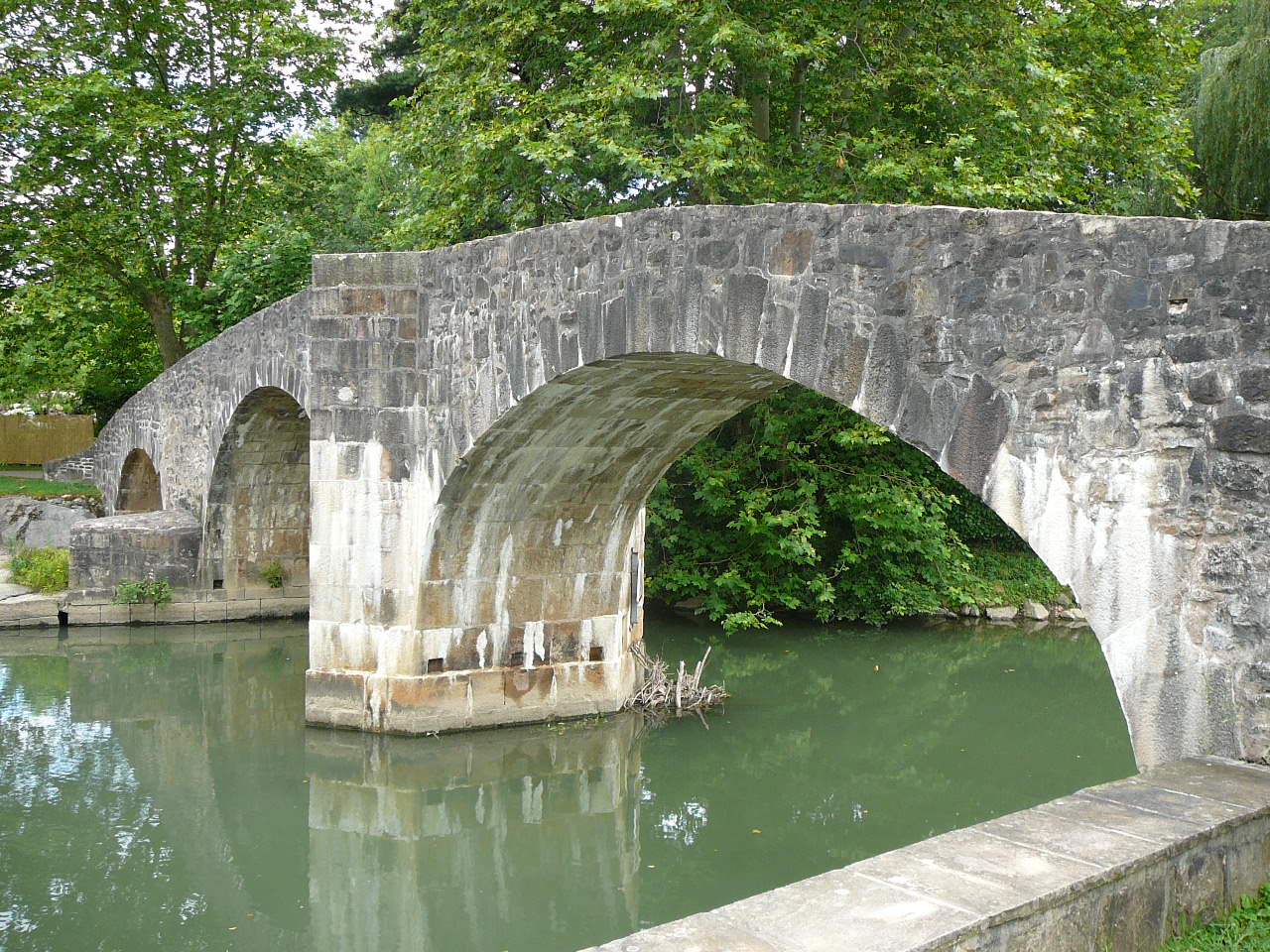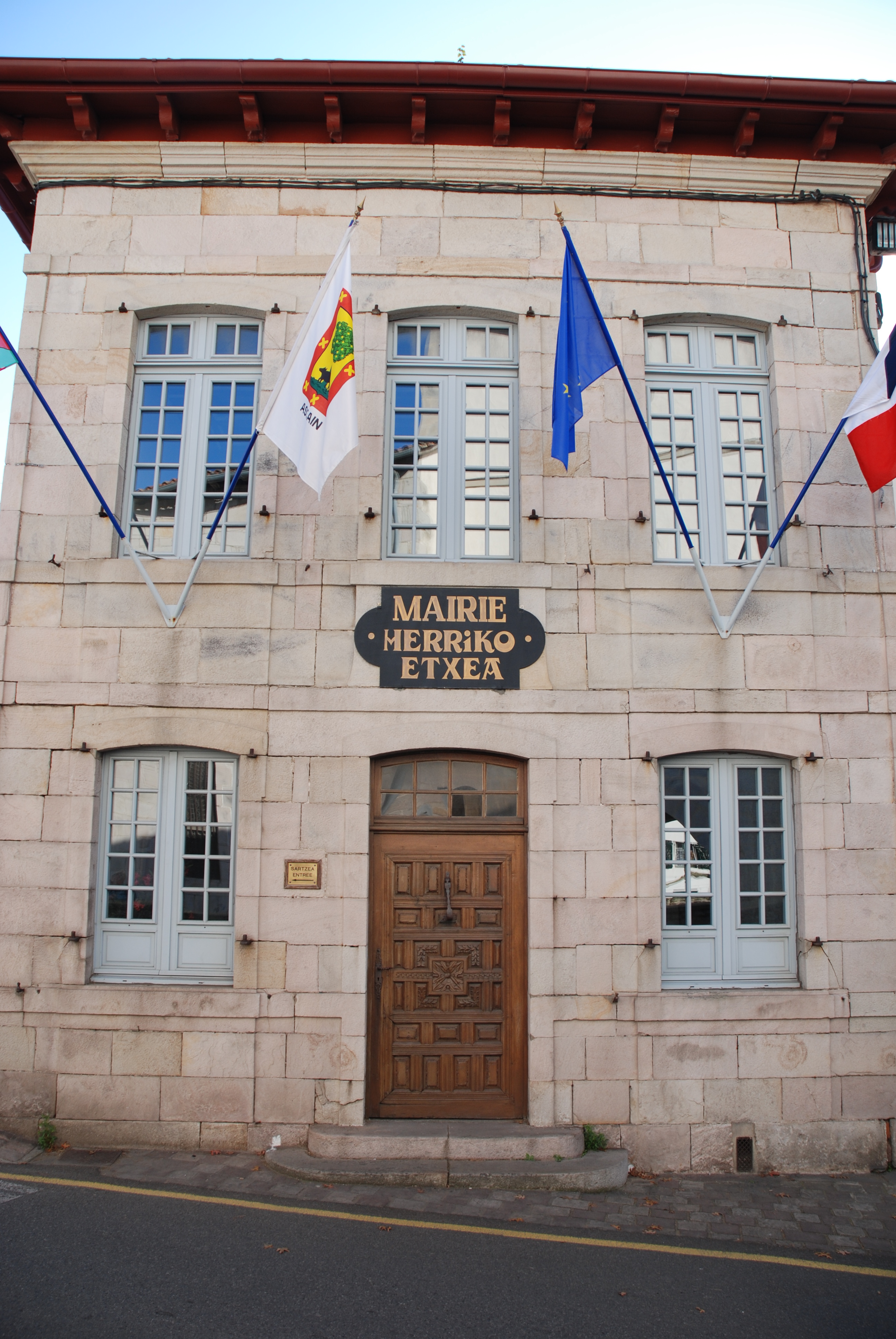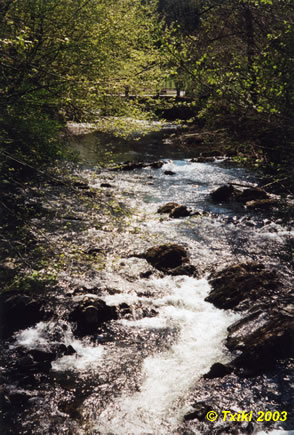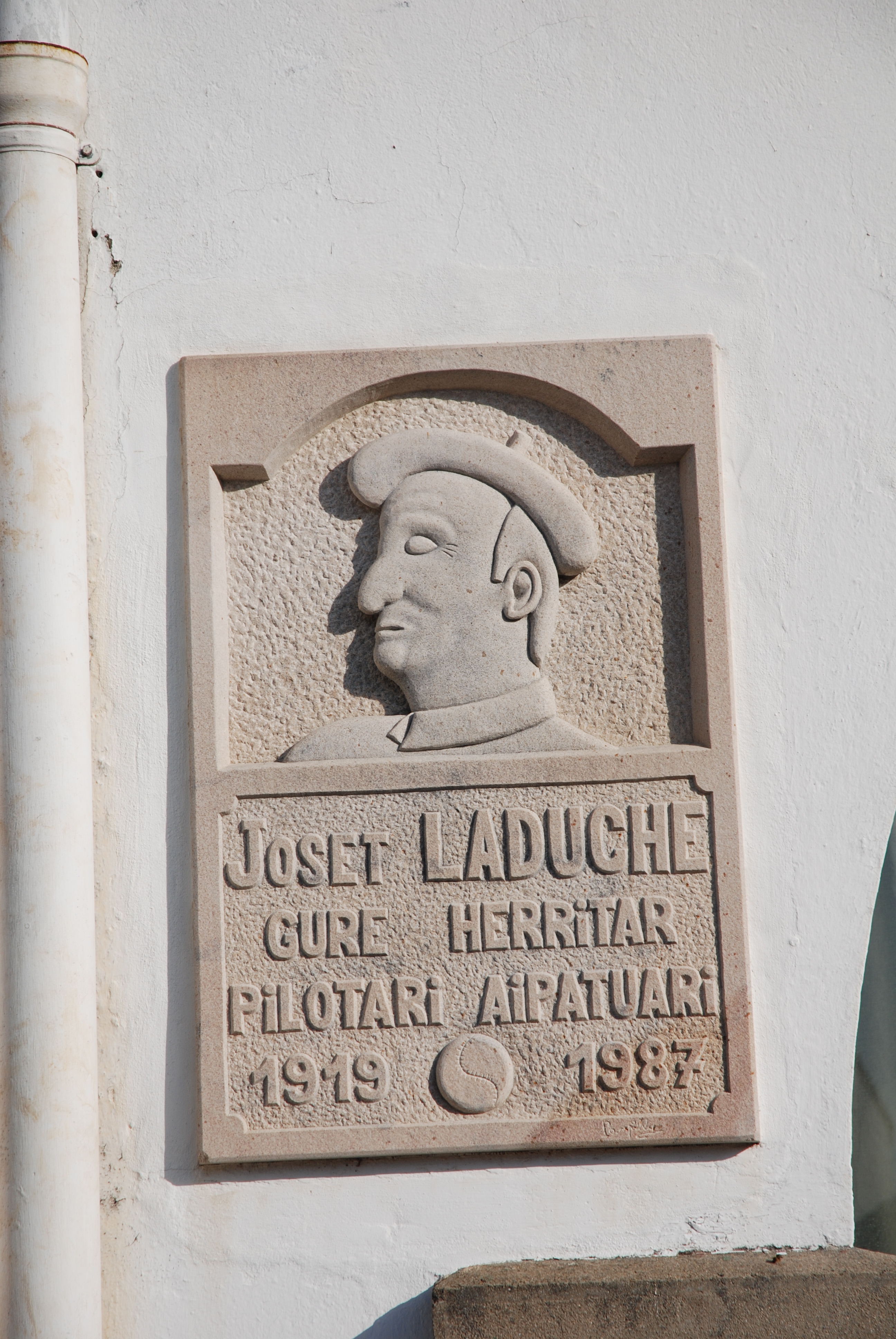Ascain Nivelle 1.JPG on:
[Wikipedia]
[Google]
[Amazon]
Ascain (; eu, Azkaine) is a
(Basque) The commune has been awarded three flowers by the ''National Council of Towns and Villages in Bloom'' in the ''Competition of cities and villages in Bloom''.


 Ascain is part of the urban area of Bayonne in the traditional
Ascain is part of the urban area of Bayonne in the traditional
commune
A commune is an alternative term for an intentional community. Commune or comună or comune or other derivations may also refer to:
Administrative-territorial entities
* Commune (administrative division), a municipality or township
** Communes of ...
in the Pyrénées-Atlantiques
Pyrénées-Atlantiques (; Gascon Occitan: ''Pirenèus Atlantics''; eu, Pirinio Atlantiarrak or ) is a department in the southwest corner of France and of the region of Nouvelle-Aquitaine. Named after the Pyrenees mountain range and the Atlant ...
department in the Nouvelle-Aquitaine
Nouvelle-Aquitaine (; oc, Nòva Aquitània or ; eu, Akitania Berria; Poitevin-Saintongeais: ''Novéle-Aguiéne'') is the largest administrative region in France, spanning the west and southwest of the mainland. The region was created by ...
region of south-western France
France (), officially the French Republic ( ), is a country primarily located in Western Europe. It also comprises of overseas regions and territories in the Americas and the Atlantic, Pacific and Indian Oceans. Its metropolitan area ...
.
The inhabitants of the commune are known as ''Azkaindar''.Euskaltzaindia - Academy of the Basque language(Basque) The commune has been awarded three flowers by the ''National Council of Towns and Villages in Bloom'' in the ''Competition of cities and villages in Bloom''.
Geography
 Ascain is part of the urban area of Bayonne in the traditional
Ascain is part of the urban area of Bayonne in the traditional Basque
Basque may refer to:
* Basques, an ethnic group of Spain and France
* Basque language, their language
Places
* Basque Country (greater region), the homeland of the Basque people with parts in both Spain and France
* Basque Country (autonomous co ...
province of Labourd 13 km east of Irun
Irun ( es, Irún, eu, Irun) is a town of the Bidasoaldea region in the province of Gipuzkoa in the Basque Autonomous Community, Spain.
History
It lies on the foundations of the ancient Oiasso, cited as a Roman-Vasconic town.
During the Span ...
and south of Saint-Jean-de-Luz
Saint-Jean-de-Luz (; eu, Donibane Lohitzune,Donibane Lohitzune
Atlantic Ocean The Atlantic Ocean is the second-largest of the world's five oceans, with an area of about . It covers approximately 20% of Earth's surface and about 29% of its water surface area. It is known to separate the " Old World" of Africa, Europe ...
in the western foothills of the Pyrenees. The southern tip of the commune touches the border with Spain at the peak of Larrun mountain. Access to the commune is by the D4 road from Urrugne in the north-west coming into the commune from the west then passing through the town and continuing south-east to Sare, Pyrénées-Atlantiques, Sare. The D918 also comes from Atlantic Ocean The Atlantic Ocean is the second-largest of the world's five oceans, with an area of about . It covers approximately 20% of Earth's surface and about 29% of its water surface area. It is known to separate the " Old World" of Africa, Europe ...
Saint-Jean-de-Luz
Saint-Jean-de-Luz (; eu, Donibane Lohitzune,Donibane Lohitzune
Google Maps
/ref> The summit of Larrun, a mountain iconic of the Basque country, is situated approximately south of the town at the southern tip of the commune on the border with Spain. The summit can be reached by the Petit train de la Rhune, which commences from the Col de Saint-Ignace, to the east of the town outside the commune on the D4 road to Sare, Pyrénées-Atlantiques, Sare. The Interurban Network of Pyrénées-Atlantiques bus line has two stops in the commune: one for Route 863 which runs from Hasparren to Saint-Jean-de-Luz; and Route 858 between Sare and Saint-Jean-de-Luz. The Nivelle river flows through the north of the commune flowing towards the west parallel to the D918 on its way to the



 Géoportail
Géoportail
Institut géographique national, IGN
''Topographic Dictionary of the Department of Basses-Pyrenees''
1863, on the page numbers indicated in the table. ''Topographic Dictionary of the Department of Basses-Pyrenees''
Paul Raymond (archivist), Paul Raymond, Imprimerie nationale, 1863, Digitised from Lyon Public Library 15 June 2011 *Lhande: Basque-French Dictionary by Pierre Lhande.Pierre Lhande, Dictionnaire basque-français, 1926. *Orpustan: Jean-Baptiste Orpustan,
'' New Basque Toponymy''
ref name="Orpustan">Jean-Baptiste Orpustan,
''New Basque Toponymy''
Presses universitaires de Bordeaux, 2006, Origins: *Bayonne: Cartulary of Bayonne or ''Livre d'Or'' (Book of Gold)Manuscript from the 14th century in the Departmental Archives of Pyrénées-Atlantiques *Chapter: Titles of the Chapter of BayonneChapter of Bayonne in the Departmental Archives of Pyrénées-Atlantiques *Labourd: Titles of LabourdTitles of Labourd in the Departmental Archives of Pyrénées-Atlantiques *Collations: Collations of the Diocese of BayonneManuscripts from the 17th and 18th centuries in the Departmental Archives of Pyrénées-Atlantiques


 ;Mayor (France), Mayors from 1941
;Mayor (France), Mayors from 1941
 The commune is part of eight inter-communal structures:
* the Communauté d'agglomération du Pays Basque;
* the AEP association of Nive Nivelle;
* the Energy association of Pyrénées-Atlantiques;
* the inter-communal association for secondary educational colleges of Saint-Jean-de-Luz;
* the inter-communal association for the rescue centre in Saint-Jean-de-Luz;
* the SIED Côte Basque Sud;
* the association to support Basque culture.
* the Basque Bayonne - San Sebastián Eurocity.
The commune is part of eight inter-communal structures:
* the Communauté d'agglomération du Pays Basque;
* the AEP association of Nive Nivelle;
* the Energy association of Pyrénées-Atlantiques;
* the inter-communal association for secondary educational colleges of Saint-Jean-de-Luz;
* the inter-communal association for the rescue centre in Saint-Jean-de-Luz;
* the SIED Côte Basque Sud;
* the association to support Basque culture.
* the Basque Bayonne - San Sebastián Eurocity.
File:Ascain (Pyr-Atl., Fr) église.JPG, Church of the Assumption at Ascain
Image:Ascain Eglise 3.JPG, Modern Virgin
Image:Ascain Eglise 4.JPG, Plaque in pink sandstone from Larrun dating to 1648
File:Ascain Horloge.JPG, Clock on the church
File:Ascain Eglise 1.JPG, Church entrance
File:Ascain Eglise 5.JPG, Statue
File:Ascain Eglise 2.JPG, Pulpit and gallery
File:Ascain - Église Notre-Dame-de-l'Assomption - 2.jpg, The Altar
File:Ascain Eglise 13.JPG, Bas-relief
File:Ascain Eglise 12.JPG, The Nave
File:Ascain Eglise 10.JPG, Statue of Saint Antoine
File:Ascain Stèle 1.JPG, Hilarri
File:Ascain Svatiska.jpg, Swastika Hilarri
File:Ascain Stèle discoïdale.jpg, Hilarri
File:Ascain Stèle 2.JPG, Stele of General Jean-Pierre Ritter
The Chapel of Serres, dedicated to Saint Jacques and recently restored was, in the Middle Ages, a waystation on the Way of St. James.Fascicule, ''Ascain-Azkaine'' prefaced by Léon Labayen
A Music school (Kornelio), in the form of an association offers classic and traditional training.Presentation of the main associations in Ascain from the commune website
The ''Larrundarrak'' drum band, the ''Larrun Kanta'' choir, and the ''Martintxo-Altxalili'' association complete the musical offerings of the commune.
 *Johannes de Sossiondo, born at Ascain, Bishop of Bayonne from 1566 to 1578;Philippe Veyrin, ''The Basques'', Arthaud, 1975, , page 113
*Edmé-Martin Vandermaesen, born in 1766 at Versailles (city), Versailles and died in 1813 at Ascain, was a Divisional general, mortally wounded at
*Johannes de Sossiondo, born at Ascain, Bishop of Bayonne from 1566 to 1578;Philippe Veyrin, ''The Basques'', Arthaud, 1975, , page 113
*Edmé-Martin Vandermaesen, born in 1766 at Versailles (city), Versailles and died in 1813 at Ascain, was a Divisional general, mortally wounded at
Google Maps
/ref> The summit of Larrun, a mountain iconic of the Basque country, is situated approximately south of the town at the southern tip of the commune on the border with Spain. The summit can be reached by the Petit train de la Rhune, which commences from the Col de Saint-Ignace, to the east of the town outside the commune on the D4 road to Sare, Pyrénées-Atlantiques, Sare. The Interurban Network of Pyrénées-Atlantiques bus line has two stops in the commune: one for Route 863 which runs from Hasparren to Saint-Jean-de-Luz; and Route 858 between Sare and Saint-Jean-de-Luz. The Nivelle river flows through the north of the commune flowing towards the west parallel to the D918 on its way to the
Atlantic Ocean
The Atlantic Ocean is the second-largest of the world's five oceans, with an area of about . It covers approximately 20% of Earth's surface and about 29% of its water surface area. It is known to separate the " Old World" of Africa, Europe ...
. Several tributaries rise in the south of the commune and flow north, gathering many more tributaries, into the Nivelle. These streams include the Aniberreko Erreka, the Galardiko Erreka, and the Arraioko Erreka. The Larrunko Erreka forms the south-western border of the commune as it flows north then west to join the Intsolako Erreka which continues north to join the Aniberreko Erreka.
Places and hamlets
* Aïra-Harri * Aldagarai * Ansorlua * Apituxenborda * Arginenia * Arraioa * Askubea * Biscarzoun or Bizkarzun (redoubt) * Bordatxoenia * Dorria * Errotenea * Esnaur (redoubt) * Etxegaraia * Hiriburua * Ihizelaia * Indartea * Jauregikoborda * Kisu Labea * Lanzelai (ZA) * Larrunzola * Lur Eder * Manttobaita * Martinhaurrenborda * Miramar * Monségur * Morzelai * Muga * Nausienborda * Oihanetxeberria * Paxkulinenea * Portua * Larrun * Sabadinenborda * Sainte-Hélène * Serres * Telleriaberria * Xakarroko Errota * Xeruenborda * Xorroetaberria * Xuanenborda * Zelaia * Zelaiakoborda


 Géoportail
GéoportailInstitut géographique national, IGN
Toponymy
The commune name in basque is ''Azkaine''. The name ''Ascain'' probably comes from ''haitz gain'' meaning "top of the hill" or "rocky height".Brigitte Jobbé-Duval, ''Dictionary of place names - Pyrénées-Atlantiques'', 2009, Archives and Culture, The following table details the origins of the commune name and other names in the commune. Sources: *Goyheneche: Eugène Goyheneche, ''Basque Country: Soule, Labourd, Basse-Navarre''Eugène Goyheneche, ''Basque Country: Soule, Labourd, Basse-Navarre'', Société nouvelle d'éditions régionales et de diffusion, Pau, 1979, bnf FRBNF34647711, p. 583 *Paul Raymond (archivist), Raymond:''''Topographic Dictionary of the Department of Basses-Pyrenees''
1863, on the page numbers indicated in the table. ''Topographic Dictionary of the Department of Basses-Pyrenees''
Paul Raymond (archivist), Paul Raymond, Imprimerie nationale, 1863, Digitised from Lyon Public Library 15 June 2011 *Lhande: Basque-French Dictionary by Pierre Lhande.Pierre Lhande, Dictionnaire basque-français, 1926. *Orpustan: Jean-Baptiste Orpustan,
'' New Basque Toponymy''
ref name="Orpustan">Jean-Baptiste Orpustan,
''New Basque Toponymy''
Presses universitaires de Bordeaux, 2006, Origins: *Bayonne: Cartulary of Bayonne or ''Livre d'Or'' (Book of Gold)Manuscript from the 14th century in the Departmental Archives of Pyrénées-Atlantiques *Chapter: Titles of the Chapter of BayonneChapter of Bayonne in the Departmental Archives of Pyrénées-Atlantiques *Labourd: Titles of LabourdTitles of Labourd in the Departmental Archives of Pyrénées-Atlantiques *Collations: Collations of the Diocese of BayonneManuscripts from the 17th and 18th centuries in the Departmental Archives of Pyrénées-Atlantiques
History
In 1609 Councillor Pierre de Lancre intervened in French Basque Country at the head of a commission of inquiry demanded by Henri IV. The commission was to "purge the country of all sorcerers and sorceresses under the influence of demons". The priest of Ascain was degraded then burned. The Bishop of Bayonne, Jean VI de Sossiondo, built a large house called "Askunda" here during the middle of the 16th century, which can still be seen. In 1794, at the height of Reign of Terror, The Terror and after the desertion of 47 young people from Itxassou, the Committee of Public Safety (Decree of 13 Ventôse Year II - 3 March 1794) arrested and deported some of the men, women, and children from Ainhoa, Pyrénées-Atlantiques, Ainhoa, Ascain, Espelette, Itxassou, Sare, Pyrénées-Atlantiques, Sare, and Souraïde; and declared the commune, as for other communes near the Spanish border, a "Notorious commune". This measure was also extended to Biriatou, Cambo-les-Bains, Cambo, Larressore, Louhossoa, Mendionde, and Macaye. The inhabitants were: "gathered in various national houses or in the District of Ustaritz or in those of the ''Grande Redoubt'', such as Jean-Jacques Rousseau". In reality they were gathered in the churches then deported in very precarious conditions to Bayonne, Capbreton, Saint-Vincent-de-Tyrosse, and Ondres. Departments where people from the communes were interned were Lot (department), Lot, Lot-et-Garonne, Gers, Landes (department), Landes, Basses-Pyrénées (the Béarnais part), and Hautes-Pyrénées. The return of the exiles and the recovery of their properties were determined by a series of decrees issued on 29 September and 1 October 1794 - driven in this direction by the Director of Ustaritz: "The former communes of Sare, Itxassou, Ascain, Biriatou, and Serres, whose inhabitants have been interned for eight months as a measure of general security people have not been able to farm. The people who wish to obtain freedom to retire to their homes are clamouring for food without us being able to provide them with the means to fulfil this first human need, hunger". The recovery of property was not done without difficulty: their properties had been sequestered but were not registered and so were looted: "Movable and immovable property of the inhabitants of Sare, were neither legally recognized nor disclosed; all our furniture and household effects were removed and brought confusedly to neighbouring communes. Instead of putting them in safe places, some were sold at auction or to any other party without auction".Heraldry
These arms were registered for the first time on 5 July 1405 by Juan Martinez de Agorreta y Ascain, Lord of Agorreta and Ascain, who married Princess Leonor Tocco de Acciaioli, from the Florence House of Acciaioli.the History page on the commune websiteAdministration
List of Successive Mayors
 ;Mayor (France), Mayors from 1941
;Mayor (France), Mayors from 1941
Inter-communality
 The commune is part of eight inter-communal structures:
* the Communauté d'agglomération du Pays Basque;
* the AEP association of Nive Nivelle;
* the Energy association of Pyrénées-Atlantiques;
* the inter-communal association for secondary educational colleges of Saint-Jean-de-Luz;
* the inter-communal association for the rescue centre in Saint-Jean-de-Luz;
* the SIED Côte Basque Sud;
* the association to support Basque culture.
* the Basque Bayonne - San Sebastián Eurocity.
The commune is part of eight inter-communal structures:
* the Communauté d'agglomération du Pays Basque;
* the AEP association of Nive Nivelle;
* the Energy association of Pyrénées-Atlantiques;
* the inter-communal association for secondary educational colleges of Saint-Jean-de-Luz;
* the inter-communal association for the rescue centre in Saint-Jean-de-Luz;
* the SIED Côte Basque Sud;
* the association to support Basque culture.
* the Basque Bayonne - San Sebastián Eurocity.
Twinning
Ascain has Twin towns and sister cities, twinning associations with: * Bollendorf (Germany) since 1979. * Lesaka (Spain) since 1980.Demography
In 1670 the commune had 300 Feu fiscal, fires and in 1718 1,560 inhabitants. In 2017 the commune had 4,194 inhabitants.Economy
Economic activity is mainly agricultural and also tourism. There is a sandstone quarry in the commune. Ascain is part of the Appellation d'origine contrôlée (AOC) zone of Ossau-iraty. There are two breweries (Akerbeltz and Oldarki) in the commune.Culture and heritage
According to the ''Map of the Seven Basque Provinces'' edited in 1863 by Prince Louis-Lucien Bonaparte, the Basque language, basque dialect spoken in Ascain is Labourdin. The film ''La Danseuse Orchidée'' by Léonce Perret was partly filmed in Ascain in 1928 with Chiquito de Cambo.Civil heritage
There are several buildings and structures in Ascain that are registered as historical monuments. These are: *House of Ferdinand Pinney Earle (20th century)Ministry of Culture, Mérimée *Redoubt of Biscarzoun (partly in Saint-Pée-sur-Nivelle) (19th century)Ministry of Culture, Mérimée *Redoubt of Esnaur (1813)Ministry of Culture, Mérimée *Roman bridge on the Nivelle (5th century). It was rebuilt after the collapse of the central pier caused by flooding of the Nivelle in December 1994. *Group of nine Stone circles at Aïra-Harri (Protohistoric)Ministry of Culture, Mérimée The two redoubts were part of the defence by Nicolas Jean-de-Dieu Soult, Marshal Soult of the Franco-Spanish border against the British Army under Arthur Wellesley, 1st Duke of Wellington, Wellington in 1813. In 1947 the village erected the first ''Stèle des évadés de France'' (Stele of escapees of France) in memory of the resistance fighters who left France to join the Free French Forces via Spain during the Second World War.Religious heritage
The Church of the Assumption has some medieval remains. It was enlarged in the 16th and 17th centuries and was inaugurated under Louis XIII in 1626. In 1605 Monseigneur Bertrand d'Etchaux, Bishop of Bayonne, visited the parish of Ascain and permitted "the said parishioners of the said parish to sell or dispose of the tombs that seem good in favour of the proceeds of the sale"... (be used for) ..."the keeping, repair, and completion of the work on the church". Inside the church is a Statue of the Virgin and Child which is a cast of a statue from the 14th century: the original in marble, called the ''Virgin of Longchamp'', is preserved in the Musée national du Moyen Âge (National Museum of the Middle Ages) in Paris. Tombstones in pink sandstone from Larrun cover the grounds.Facilities
Education
The commune has three primary schools: one public, one private catholic (Sainte-Marie school), and one Ikastola (Basque language school).Education page on the commune websiteA Music school (Kornelio), in the form of an association offers classic and traditional training.Presentation of the main associations in Ascain from the commune website
The ''Larrundarrak'' drum band, the ''Larrun Kanta'' choir, and the ''Martintxo-Altxalili'' association complete the musical offerings of the commune.
Sports and sports facilities
There are several sports associations in the commune including associations for sport of athletics, athletics, basketball, cycle sport, cycling, traditional dance, gymnastics, basque pelota, hiking, rugby union, and tennis.Notable people linked to the commune
Saint-Jean-de-Luz
Saint-Jean-de-Luz (; eu, Donibane Lohitzune,Donibane Lohitzune
Gérard Moutche, ''What do Basque houses say?'', Atlantica, 2010, Paris, , pages 58-59. *Joseph Laduche, born at Ascain in 1919, father of Jean, Philippe, Jean Michel, Marie Jo, Pampi, and Martine Laduche, who became Champion of France in basque pelota in 1941; *Maurice Abeberry born at Biarritz in 1926 and died at Ascain in 1988, was a doctor of law, lawyer, sports administrator, and music-lover; *Léon Berho born on 4 June 1932 at Ascain and died at Dax, Landes, Dax in October 2011, was a rugby union player, finalist in the championship of France in 1961, 1963, and 1966 with US Dax; *Philippe Laduche, born at Ascain in 1946, played basque pelota and became world champion in Basque trinquete in 1970 at Saint-Sébastian; *Pampi Laduche, born in 1955 at Ascain, was a basque pelota player, world champion in Basque trinquete in 1974 at Montevideo (Uruguay). *Martine Laduche, born in 1960 at Ascain, was a basque pelota player of ''panla ancha'' and bare hands, champion of France. *Jacques Chaban-Delmas, born in 1915 at Paris and died in 2000 at Paris, was Mayor of Bordeaux, Prime Minister, Honorary President of the National Assembly, General of the Resistance, buried in the cemetery at Ascain where he had a second home.
AZKAINE in the Bernardo Estornés Lasa - Auñamendi Encyclopedia (Euskomedia Fundazioa)
Ascain official website
Ascain on Géoportail
Institut géographique national, National Geographic Institute (IGN) website
''Ascain'' on the 1750 Cassini Map
{{authority control Communes of Pyrénées-Atlantiques
Gérard Moutche, ''What do Basque houses say?'', Atlantica, 2010, Paris, , pages 58-59. *Joseph Laduche, born at Ascain in 1919, father of Jean, Philippe, Jean Michel, Marie Jo, Pampi, and Martine Laduche, who became Champion of France in basque pelota in 1941; *Maurice Abeberry born at Biarritz in 1926 and died at Ascain in 1988, was a doctor of law, lawyer, sports administrator, and music-lover; *Léon Berho born on 4 June 1932 at Ascain and died at Dax, Landes, Dax in October 2011, was a rugby union player, finalist in the championship of France in 1961, 1963, and 1966 with US Dax; *Philippe Laduche, born at Ascain in 1946, played basque pelota and became world champion in Basque trinquete in 1970 at Saint-Sébastian; *Pampi Laduche, born in 1955 at Ascain, was a basque pelota player, world champion in Basque trinquete in 1974 at Montevideo (Uruguay). *Martine Laduche, born in 1960 at Ascain, was a basque pelota player of ''panla ancha'' and bare hands, champion of France. *Jacques Chaban-Delmas, born in 1915 at Paris and died in 2000 at Paris, was Mayor of Bordeaux, Prime Minister, Honorary President of the National Assembly, General of the Resistance, buried in the cemetery at Ascain where he had a second home.
See also
*Communes of the Pyrénées-Atlantiques department *End of Basque home rule in FranceReferences
External links
AZKAINE in the Bernardo Estornés Lasa - Auñamendi Encyclopedia (Euskomedia Fundazioa)
Ascain official website
Ascain on Géoportail
Institut géographique national, National Geographic Institute (IGN) website
''Ascain'' on the 1750 Cassini Map
{{authority control Communes of Pyrénées-Atlantiques